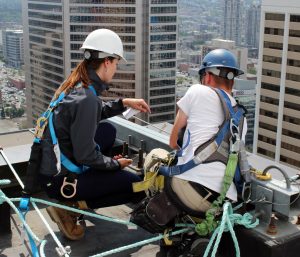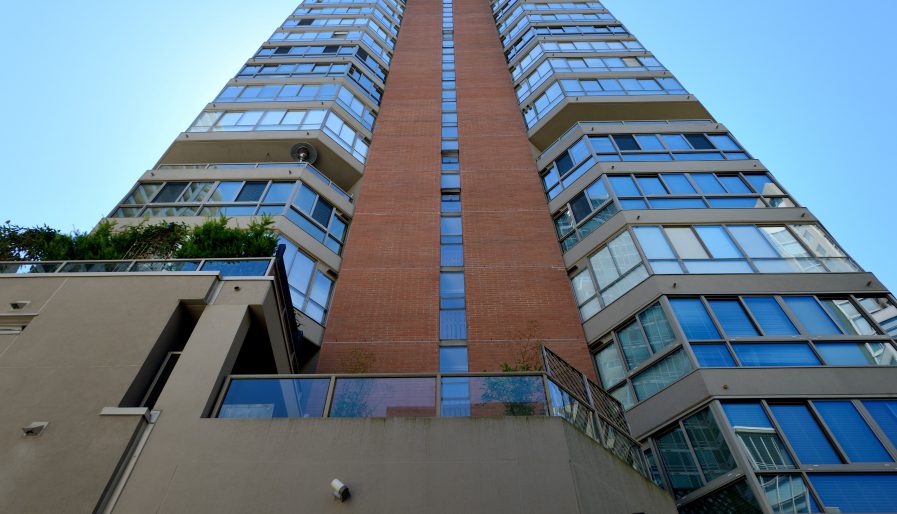When it comes to maintaining your building envelope and structure, periodic reviews are recommended by the experts to prevent key assemblies from failing. A failure may develop gradually from general wear and tear, or suddenly due to a dramatic weather event, a construction deficiency, or a myriad of other reasons.
To ensure your building remains in safe, working order for the long-haul, Nikolas Marsall-Moritz, Project Engineer with RJC Engineers, advises building owners and managers conduct periodic reviews of the physical asset, particularly in the following key areas:
1. The exterior envelope
The exterior envelope is made up of several systems that prevent moisture from accessing the building interior, including roofing and walls. These systems are prone to nuisance leakage, or in more extreme scenarios, failing to prevent deterioration of the structure.
“While the specifics of a review will depend on the individual building, it generally begins with a discussion with the management company or Board about any known moisture ingress issues, followed by a visual review of the exterior to identify areas of deterioration, moisture staining or outright failed assemblies,” he says. “A more in-depth review into specific problem areas may entail the removal and replacement of exterior or interior finishes to examine hidden construction and their condition.”
Reviews should also identify safety issues like loose cladding or flashing. “While in shorter buildings, a review may be possible from the ground using binoculars, in taller ones, a close-up review via swingstage or rope access is usually warranted,” he says. “This allows the reviewer to physically examine suspect areas than may not be evident from a distance.”
How often is it recommended?
It all depends on the assemblies themselves. For example, most roofing associations recommend that a roof be reviewed every one or two years, but even this may vary. “If your roof was recently replaced, conducting reviews may be a condition of the warranty,” he says. “Also, certain municipalities may have bylaws that mandate timelines between reviews.” To be safe, Marsall-Moritz recommends speaking with a professional about your specific building.
 2. Fall protection systems
2. Fall protection systems
Exterior access systems such as fall protection/tieback anchors and horizontal lifelines allow maintenance workers to safely access certain areas of the building’s exterior. Where there is a fall hazard, it is vital to ensure these systems are in serviceable condition and proper working order.
“A review generally involves examining the system for signs of deterioration, damage, or deflection,” he says. “The reviewer will also take a look at the overall system, and will notify you if there are any changes to the applicable codes that result in the system no longer meeting current standards. Certain assemblies may also be load tested to ensure they continue to be able to support required loads.”
How often is it recommended?
Current CSA standards require that fall protection systems are reviewed annually, or prior to use if these systems are not frequently used. But given window washing relies on these systems for taller buildings, an annual review is usually the norm.
3. Parkades and parking areas
While these areas can include exterior on-grade asphalt lots, Marsall-Moritz warns that suspended parking areas are of particular concern. Suspended slabs are the ones in which the underside is not in direct contact with the ground, and there is often usable space below. Like with the building envelope, moisture ingress can lead to deterioration, making suspended parking areas more susceptible to wear and tear, as well as chlorides (salt) brought in from vehicles.
“For suspended parking areas, reviews generally involve a visual assessment of any exposed waterproofing for signs of damage or wear, as well as a review of the underside for leakage staining,” he says. “Sometimes a flood test is also conducted, generally in concert with a periodic cleaning event to help identify areas of failed waterproofing.”
Acoustic sounding in the form of a chain drag or hammer sound is also common to help identify areas where the waterproofing may look fine, but the concrete beneath is deteriorated. On-grade areas reviews are also advised for safety concerns, like tripping hazards or pooling water.
How often is it recommended?
While there is no mandated review period for parkades, Marsall-Moritz recommends doing one every year or two depending on usage.
4. Post-tensioned systems
Post-tensioning is a structural concrete reinforcement system that is used less regularly today than it was in the 1950s through 80s. For older buildings with this system, there is an increased risk of damage from moisture ingress, which can result in corrosion of the steel strand, and eventually cause breakage.
“A review of post-tensioned assemblies typically involves conducting a penetration test at a sample of previously exposed strands at an existing recess,” he says, pointing out that “a recess” can generally be identified by a steel plate bolted to the underside of a concrete slab. “The test will identify whether the stand is still under tension, and therefore continuing to reinforce and support the concrete structure.”
How often is it recommended?
The general recommendation for PT system reviews is once every year or two depending on condition and history of deterioration. Each report should outline these details including when the next review should be undertaken.
The key benefits of periodic reviews
“All periodic reviews can potentially identify problems before they become significant, while also helping condominiums plan replacement expenditures and inform their reserve fund studies,” he says.
Additionally, certain mortgage and insurance conditions require them: “A PT structure must be reviewed as per the most recent recommended timeframe. Failure to have a review available may impact a unit’s ability to be sold—and in terms of fall protection systems, professional companies will not permit their workers to use anchors that have not been reviewed.”
The bottom line is, by conducting these four periodic reviews, you will be staving off serious issues and prolonging the integrity of your building, while keeping workers and occupants safe.
To find out more about these and other periodic reviews, visit www.rjc.ca or contact Nikolas Marsall-Moritz directly.





